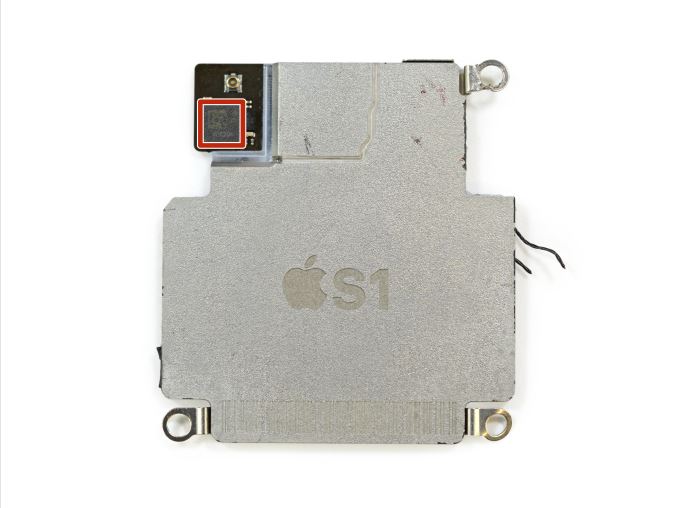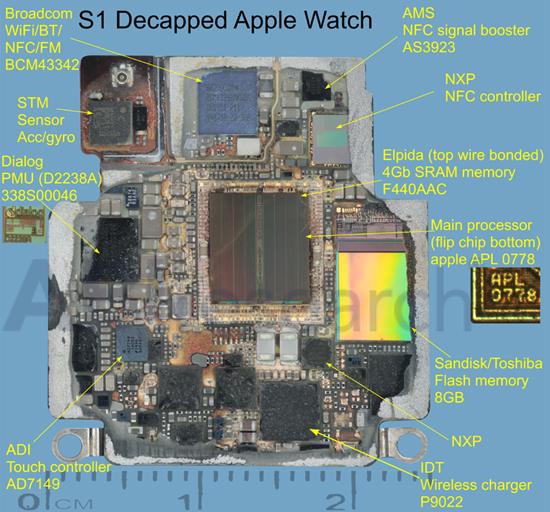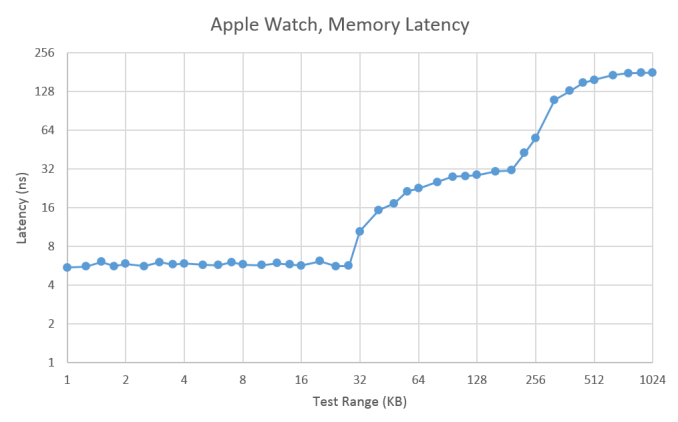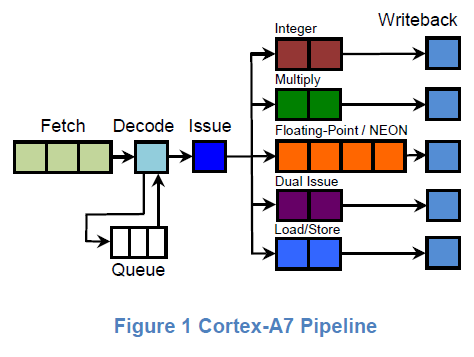The Apple Watch Review
by Joshua Ho & Brandon Chester on July 20, 2015 8:00 AM EST- Posted in
- Wearables
- Apple
- Mobile
- Apple Watch
Apple S1 Analysis
One of the biggest issues with the smartwatch trend that I’ve seen is that as a result of most companies entering the market with smartphone backgrounds, we tend to see a lot of OEMs trying to shove smartphone parts into a smartwatch form factor. There have been a lot of different Android Wear watches, but for the most part everything seems to use Qualcomm’s Snapdragon 400 without the modem. Even though A7 is relatively low power for a smartphone, it’s probably closer to the edge of what is acceptable in terms of TDP for a smartwatch. Given that pretty much every Android Wear watch has around a 400 mAh battery at a 3.8 or 3.85 volt chemistry to attempt to reach 1-2 days of battery life and a relatively large PCB, the end result is that these smartwatches are really just too big for a significant segment of the market. In order to make a smartwatch that can scale down to sizes small enough to cover most of the market, it’s necessary to make an SoC specifically targeted at the smartwatch form factor.

Capped Apple S1 SoC (Image Courtesy iFixit)
The real question here is what Apple has done. As alluded to in the introduction, it turns out the answer is quite a bit. However, this SoC is basically a complete mystery. There’s really not much in the way of proper benchmarking tools or anything that can be run on the Watch to dig deeper here. Based on teardowns, this SoC is fabricated on Samsung’s 28nm LP process, although it’s not clear which flavor of LP is used. It’s pretty easy to eliminate the high power processes, so it’s really just a toss-up between HKMG and poly SiON gate structure. For those that are unfamiliar with what these terms mean, the main difference that results from this choice is a difference in power efficiency, as an HKMG process has less leakage power. Given how little cost is involved in this difference in process compared to a move to 20/14nm processes, it’s probably a safe bet that Apple is using an HKMG process here especially when we look at how the move from 28LP to 28HPm at TSMC dramatically affected battery life in the case of SoCs like Snapdragon 600 and 800.

Decapped & Labeled S1 SoC (Image Courtesy ABI Research)
We also know that binaries compiled for the watch target ARMv7k. Unfortunately, this is effectively an undocumented ISA. We know that Watch OS is built on iOS/Darwin, so this means that a memory management unit (MMU) is necessary in order to make it possible to have memory protection and key abstractions like virtual memory. This rules out MCU ISAs like ARMv7m even if it's possible to add an MMU to such an architecture, so it’s likely that we’re looking at some derivative of ARMv7-A, possibly with some unnecessary instructions stripped out to try and improve power consumption.
The GPU isn’t nearly as much of a mystery here. Given that the PowerVR drivers present in the Apple Watch, it’s fairly conclusive that the S1 uses some kind of PowerVR Series 5 GPU. However which Series 5 GPU is up to debate. There are reasons to believe it may be a PowerVR SGX543MP1, however I suspect that it is in fact PowerVR's GX5300, a specialized wearables GPU from the same family as the SGX543 and would use a very similar driver. Most likely, dedicated competitive intelligence firms (e.g. Chipworks) know the answer, though it's admittedly also the kind of information we expect they would hold on to in order to sell it to clients as part of their day-to-day business activities.
In any case, given that native applications won’t arrive until WatchOS 2 is released I don’t think we’ll be able to really do much in the way of extensive digging on what’s going on here as I suspect that graphics benchmarks will be rare even with the launch of WatchOS 2.
Meanwhile, after a lot of work and even more research, we're finally able to start shining a light on the CPU architecture in this first iteration of Apple's latest device. One of the first things we can start to look at is the memory hierarchy, which is information crucial to applications that require optimization to ensure that code has enough spatial and/or temporal locality to ensure that code is performant.
As one can see, there’s a pretty dramatic fall-off that happens between 28 and 64KB of “DRAM”, as we exit the local maximum of L1 data cache, so we can safely bet that the L1 data cache size is 32KB given current shipping products tend to fall somewhere between 32 and 64KB of L1 data cache. Given the dramatic fall-off that begins to happen around 224KB, we can also safely bet that we’re looking at a 256KB L2 combined cache which is fairly small compared to the 1-2MB shared cache that we might be used to from today’s large smartphone CPUs, but compared to something like an A5 or A7 it’s about right.
If Apple had just implemented the Cortex A7 as their CPU of choice, the obvious question at this point is whether they’ve really made anything “original” here. To try and dive deeper here, we can start looking past the memory hierarchy and looking closer at the machine itself. One of the first things that is obvious is that we’re looking at a CPU with a maximum frequency of 520 MHz, which is telling of the kind of maximum power that Apple is targeting here.
| Apple S1 CPU Latency and Throughput | ||||
| Instruction | Throughput (Cycles/Result) | Latency (Cycles/Result) | ||
| Loads (ldr reg,[reg]) | 1 | N/A | ||
| Stores (str reg,[reg]) | 1 | N/A | ||
| Move (mov reg, reg) | 1/2 | - | ||
| Integer Add (add reg, reg, imm8) | 1/2 | - | ||
| Integer Add (add reg,reg,reg) | 1 | 1 | ||
| Integer Multiply (mul reg,reg,reg) | 1 | 3 | ||
| Bitwise Shift (lsl reg,reg) | 1 | 2 | ||
| Float Add (vadd.f32 reg,reg,reg) | 1 | 4 | ||
| Double Add (vadd.f64 reg,reg,reg) | 1 | 4 | ||
| Float Multiply (vmul.f32 reg,reg,reg) | 1 | 4 | ||
| Double Multiply (vmul.f64 reg,reg,reg) | 4 | 7 | ||
| Double Divide (vdiv.f64 reg,reg,reg) | 29 | 32 | ||
Obviously, talking about the cache hierarchy isn’t enough, so let’s get into the actual architecture. On the integer side of things, integer add latency is a single cycle, but integer multiplication latency is three cycles. However, due to pipelining integer multiplication throughput can produce a result every clock cycle. Similarly, bitshifts take two cycles to complete, but the throughput can be once per clock. Attempting to interleave multiplies and adds results in only achieving half the throughput. We can guess that this is because the integer add block and the integer multiply block are the same block, but that doesn’t really make sense because of just how different addition and multiplication are at the logic level.
Integers are just half of the equation when it comes to data types. We may have Booleans, characters, strings, and varying bit sizes of integers, but when we need to represent decimal values we have to use floating point to enable a whole host of applications. In the case of low power CPUs like this one, floating point will also often be far slower than integers because the rules involved in doing floating point math is complex. At any rate, a float (32-bit) can be added with a throughput of one result per cycle, and a latency of four cycles. The same is true of adding a double or multiplying a float. However, multiplying or dividing doubles is definitely not a good idea here because peak throughput of multiplying doubles is one result per four clock cycles, with a latency of 7 clock cycles. Dividing doubles has a peak throughput of a result every 29 clock cycles, with a latency of 32 clock cycles.
If you happen to have a webpage open with the latency and throughput timings for Cortex A7, you’d probably guess that this is a Cortex A7, and you’d probably be right as well. Attempting to do a load and a store together has a timing that indicates these are XOR operations which cannot be executed in a parallel manner. The same is true of multiplication and addition even though the two operations shouldn’t have any shared logic. Conveniently, the Cortex A7 has a two-wide pipeline that has similar limitations. Cortex A5 is purely single-issue, so despite some similarity it can't explain why addition with an immediate/constant value and a register can happen twice per clock.
Given the overwhelming amount of evidence at the timing level of all these instructions, it’s almost guaranteed that we’re looking at a single core Cortex A7 or a derivative of it at 520 MHz. Even if this is just a Cortex A7, targeting a far lower maximum clock speed means that logic design can prioritize power efficiency over performance. Standard cells can favor techniques and styles that would otherwise unacceptably compromise performance in a 2+ GHz chip could be easily used in a 520 MHz chip such as device stacking, sleepy stack layout, higher Vt selection with negative active body biasing, and other techniques that would allow for either lower voltage at the same frequency, or reduced capacitance in dynamic power and reduced static leakage. Given that Cortex A7 has generally been a winning design for perf/W metrics, I suspect that key points of differentiation will come from implementation rather than architecture for the near future. Although I was hoping to see Apple Watch on a more leading-edge process like 14LPP/16FF+, I suspect this will be deferred until Apple Watch 2 or 3.












270 Comments
View All Comments
Lord of the Bored - Tuesday, July 21, 2015 - link
Ah. That makes a huge difference, and I retract the complaint.As near as I could tell, it was a simple spring-latch rig, and you can understand where I was curious what people were going to say when the latch springs started sagging.
Joschka77 - Monday, July 20, 2015 - link
are you really trying to tell me, that Apple has gotten right what nobody in the whole watch making industry (including the likes of Breitling, Rolex, Tag Heuer, ....etc) hasn´t succeded in doing?"The ergonomic annoyances involved with wearing a wristwatch" have always been a nuisance to you, but Apple "on the other hand doesn’t suffer from discomfort issues at all, and in this regard, Apple has arguably pushed the industry forward"???
the whole watch making industry?
are you serious??????
wperry - Monday, July 20, 2015 - link
That stuck out in my mind as well: an admitted non-wearer of watches commenting on how the watch industry has been pushed forward. Yikes. It's like someone with a bus pass making declarative statements on the third car they've driven.mrdude - Monday, July 20, 2015 - link
All the while using the same band that reviewers have pointed out has a tendency to detach if it gets caught while pulling/putting your hands into/from your pockets.This really is one of the worst reviews I've ever read on AnandTech.
KPOM - Monday, July 20, 2015 - link
I have that band and have not had any issues with it detaching.wc2000 - Monday, July 20, 2015 - link
I think it's pretty hard (or at least not standard) to find straps as good as these below $500 (and assuming you value the smart technology as worth more than $0, that means the Apple watch is indeed pushing the industry). I've owned a few $300 to $500 watches and have found them uncomfortable.p_giguere1 - Monday, July 20, 2015 - link
The thing is that even "watch guys" are saying Apple's pushing the watch band industry forward.For instance: http://www.hodinkee.com/blog/hodinkee-apple-watch-...
"There is nothing that comes close to the fluidity, attention to detail, or simple build quality found on the Apple Watch in this price bracket."
"[...] the attention to detail on the straps and bracelets themselves is downright incredible, and when I mentioned above that nothing comes close in this price range, it is very visible when talking about straps."
"It is much nicer than any leather strap I've ever felt on a $350 analog watch."
"This "loop" style bracelet is just fantastic, and unlike the bracelet on my Omega, it just works. It's magnetized and you can close it at any size. It is light to wear, but substantial, and feels fantastic on the wrist. How does it compare to this nice Tissot with a similar bracelet? Switzerland, you don't want to know."
"In many cases, its offerings make what is coming out of Switzerland (or Asia) look amateurish."
I think you guys shouldn't underestimate Apple's ability to make good watches based on the fact other guys have been making them for longer. Remember what was said about the original iPhone?
Joschka77 above sounds a lot like Ed Colligan (Palm's CEO) in 2006: "We've learned and struggled for a few years here figuring out how to make a decent phone. PC guys are not going to just figure this out. They're not going to just walk in."
How's Palm doing now?
KPOM - Monday, July 20, 2015 - link
I've worn watches since I was 7 (I'm 39). The band mechanism on the Apple Watch definitely has the "why didn't anyone think of this before" feel to it.name99 - Monday, July 20, 2015 - link
Why do you find this so hard to understand?Donald Norman write a book in 1988 called the Design of Everyday Things which is one long rant about how badly designed is almost everything we encounter every day, from doors to faucets to toasters. It's fascinating reading it today, 25 years later, to see
(a) how aggressively Apple has followed most of what he says. (Obviously he does not talk about specifically smartphones or smart watches, but he discusses general usability principles)
(b) how little the rest of the market has been affected by his insights. Doors still suck Faucets still suck. Toasters still suck (and are dangerous as hell).
So why is it at all startling that Apple is the one company that can design a watch strap that doesn't suck?
Hell it's not just the watch strap. The crown on these $15,000 and higher watches ALSO sucks. I know someone with one of those fancy watches, with 7 diamonds floating in it and all that, and it is an utter freaking pain every daylight savings change because trying to reset the time with the crown is such a hassle --- trying to pull out this tiny little bobble on the side of the watch, then rotate it the precise amount. When Apple first showed us the digital crown I was terrified of the implications, because EVERY analog crown I have ever dealt with sucked. Fortunately I didn't need to worry --- Apple adopted the appearance of the crown, but (like the strap) actually put some freaking thought into how to make it pleasant to use.
KPOM - Monday, July 20, 2015 - link
Yes. I swap out my Apple Watch bands several times a week with ease. I replaced my bands in my regular watches with lots of difficulty every year or so.